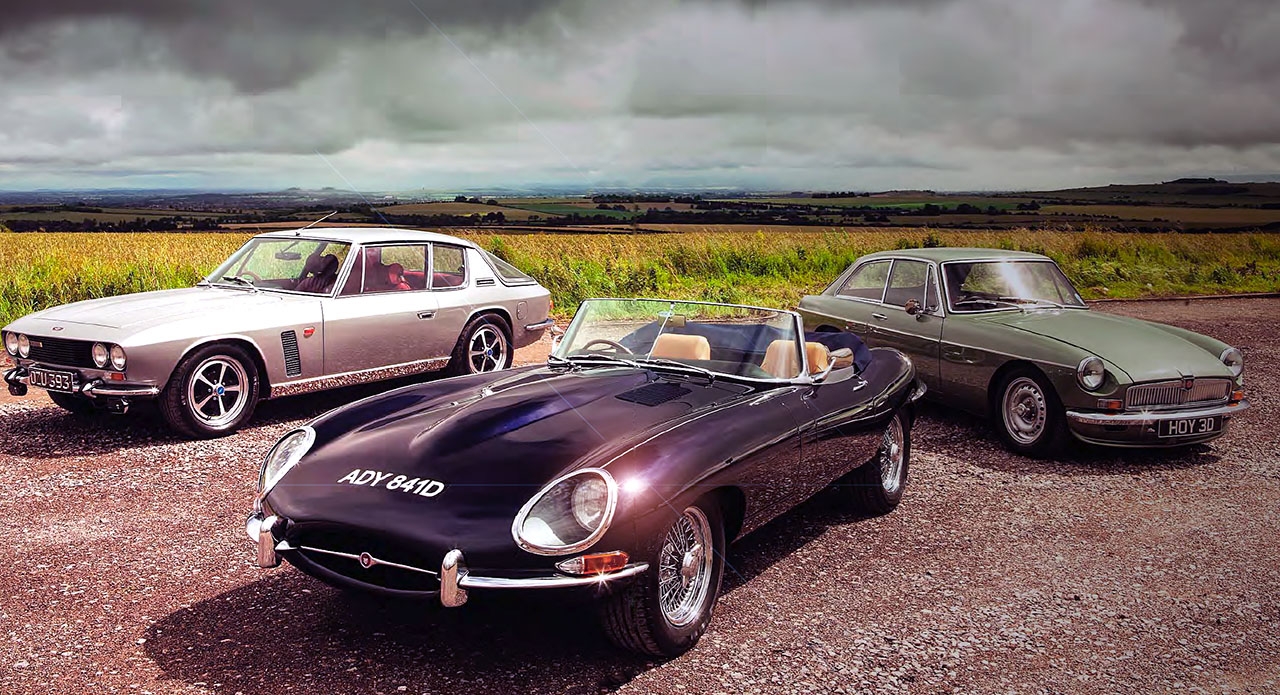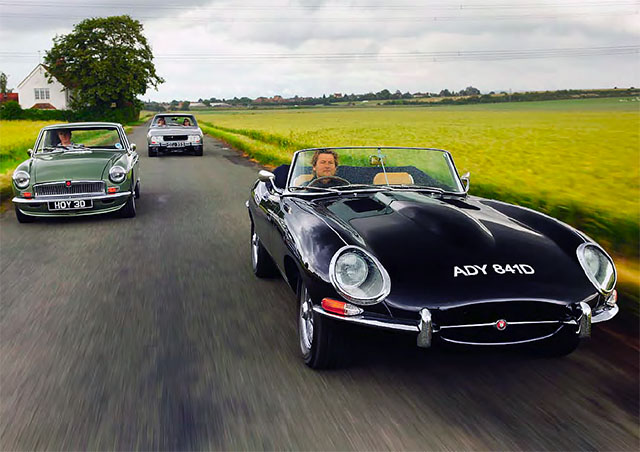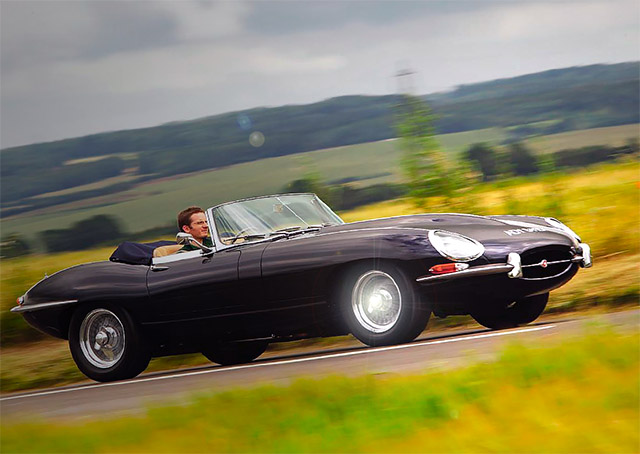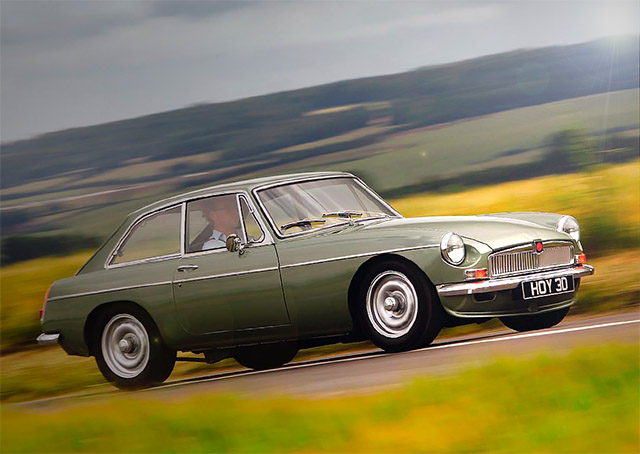
Revival of the fittest. For decades, specialists have tried to blend classic character with modern pace and usability. Now, says James Page, three of them could well have cracked it. Photography by Tony Baker.
Not many people have made themselves comfortable in an MGB and received the instruction: “Wait for the temperature to get to 70ºC, then you’re free to use the full 8000rpm.” But that’s what Frontline’s Ed Braclik just said, because the B in question is its LE50. All is therefore not quite what it seems – something that can also be said about the two cars alongside.
The Jaguar E-type is, in fact, an Eagle creation, and the Jensen has been overhauled by JIA, which has made it into an Interceptor R. Three British classics upgraded for modern use by three British firms. Actually, ‘upgraded’ is perhaps selling them short; re-engineered would be more suitable. These are not simply go-faster conversions, thrown together to give a quick fix of increased performance. They are a result of the realisation that not everyone wants to spend their weekends up to their elbows in EP90, or working their way through a never-ending job list. Some folk want a classic that needs only the sort of routine maintenance that you’d associate with a modern car. The trick is to offer that without losing the charisma of the original.

Sophisticated roadster, agile sports-GT or relaxed mile-eater: just like their period counterparts
The LE50 came about when Braclik and colleague Tim Fenna decided that they wanted to do something to celebrate the MGB’s 50th anniversary. Maybe a special set of upgrades, they thought, but one thing led to another and they found themselves settling upon the idea of a limited-edition run of 50 complete cars.
Rather than waste time and effort attempting to bring an original bodyshell up to standard, Frontline instead starts with a brand-new one from British Motor Heritage, based on the 1965 Mk1 GT. Because this uses the factory tooling, it’s classed as an original item. Each LE50 therefore retains the identity of its donor car, rather than having to assume a Q-plate. Frontline worked long and hard with BMH to modify the shell to its needs, removing rust traps such as the exterior seams, and adding strengthening to cope with the additional power.
Up front, there are aluminium wishbones and uprights, plus uprated dampers. At the rear, the live axle remains, but a five-link set-up improves its location and means, among other things, that the leaf springs and lever-arms have been replaced by coil over dampers.
Open the bonnet and, instead of the trusty B-series, you are greeted by a 2012-spec, 215bhp, 2-litre Mazda ‘four’. Featuring a steel crank and rods, plus Teflon-coated pistons, it’s the star of this particular show, weighing only 85kg. Turn the key in the centre console, prod the button and it fires instantly; blip the throttle and the revs shoot up without hesitation. At first, it’s hard to get your head around how eagerly it spins. Change gear in the superb six-speed ’box (also Mazda-sourced) purely by the sound of the engine and the force of the acceleration, and you’ll think you’re doing OK. But then you look down and realise that you’re only revving it to 5000rpm. Even when you stretch it a bit further and think that surely it can’t rev any more than that, you’ll glance at the dial and see that you’ve got 1000rpm still in hand. And that four-pot sounds glorious once it’s really working hard.

Clockwise: hard to spot tweaked front valance, lower for stability; cabin has more legroom, Eagle sports seats, air-con and iPod-ready stereo; revised suspension geometry and speed-sensitive steering
The LE50 handles beautifully, too. Turn-in is instant, without a hint of roll. The payoff, however, is that the ride is on the firm side of comfortable. It’s to Frontline’s credit, therefore, that there are no squeaks or rattles from inside – even in a demonstrator that’s done 8000 gruelling miles. It’s beautifully trimmed in leather and Alcantara: Fred Stephens, who used to work in MG’s Abingdon trim department, is now just down the road at Frontline, making the LE50’s dashboards, door cards, quarterlight assemblies and pedal boxes. The bucket seats are individually crafted in aluminium to suit each owner.
Even the instruments are modern units made by Smiths to match the look of the originals. If the LE50 is a manic pocket-rocket, the Interceptor R is a Grand Tourer through and through. JIA usually deals with the MkII/III Interceptor, but OZU 393 is the first MkI to be converted and went through its MoT test only two days before our photoshoot, which gave owner Patrick McCloskey his first drive in it.

Body, usually MkII or MkIII rather than rarer MkI, is dipped and stripped then restored, with deeper valances. Top: bespoke cabin in Bridge of Weir hide; original-style dials have modern internals
“This was the very car that started the petrol pumping through my veins at the tender age of five,” says McCloskey. “It belonged to a friend of my dad, who sold it to another friend of his. He was in the garage business and later took it off the road. As a schoolboy, I would regularly call into the garage where it was stored in a dusty corner and sit in the car, dreaming.”
After the owner died, the Jensen spent a number of years being shuttled from location to location, rapidly falling into disrepair. Eventually, McCloskey concluded a deal to buy it: “Giving it a lick and polish was never really going to be an option. It was always my aim to rebuild the car so that I could use it regularly, so I wanted reasonable handling, comfort, reliability and somewhat liveable economy.
“The only thing I didn’t care for on the Interceptor R was the modifications to the valance, indicators and exhaust etc. If we were going to build an R out of my MkI, she had to stay true to her ’60s looks. The only exception was custom alloys to allow the use of the six-pot brakes.”
The MkI’s narrower transmission tunnel meant that JIA had to fit the four-speed GM auto rather than a six-speed version, but it’s mated to a 6.2-litre V8 that you would ordinarily find in a Corvette. These come in from America as bare engines, but everything that is subsequently fitted – radiators, pipes and ancillaries – is standard GM, the idea being that a dealer will be able to easily source any replacement parts.
JIA works closely with specialist Cropredy Bridge, and each car takes nearly 2000 hours to build. Of course, if you already have a solid car, you can simply have the mechanical upgrades fitted to it. That wasn’t an option with this MkI, so it was stripped to a bare shell and acid-dipped.
When it’s all being reassembled, JIA puts extra camber and caster into the front suspension; at the rear, it starts again. The live axle is ditched in favour of a period, Jaguar-derived independent set-up that sits in its own subframe, located on strengthening plates in the rear arches. The old fuel tank would have got in the way of the diff, so a redesigned item is fitted instead.

New shell is seam-welded and available in Gunmetal Grey, Old English White and Sage Green, with Mk1 brightwork. Below: cabin features Alcantara, hide, Wilton carpets – but rear seats and air-con optional
Inside, much of the original switchgear has survived, which is a nice touch, but McCloskey’s car is now trimmed in new leather throughout – seven hides were needed to cover everything.
The instruments are classic Smiths items with new internals, and a fresh wiring loom has been installed to cope with all the upgrades. The Jensen rides serenely and handles sweetly considering its size. It certainly changes direction with more composure than the standard car. It’s comfy and easy to drive, and you could spend most of your time wafting along in relative silence. If you do feel like upping the pace, however, there’s plenty of performance. This isn’t a light car, at 1669kg, so it doesn’t feel all that quick off the mark, but its real strength lies in the way it picks up from 40-50mph. It revs well for such a big engine, and the shove in the back feels relentless once the V8 is bellowing – plus it does produce a thunderous noise. JIA offers a supercharged version with another 100bhp or so – quite how anyone would deem the ‘standard’ R to be lacking is beyond me. There’s also not much lacking in the style of Jaguar’s E-type, which is why Eagle is strict about maintaining its original look – whatever is subsequently done underneath. The only instant giveaway on this car is the use of wider wheels and tyres. Whether the starting point is a rustfree Californian shell or a complete, standard E-type, Eagle offers four basic packages from which you can mix and match: Classic focuses on improving reliability alone; GT does the same, but also tightens up the suspension. If you want serious performance, there’s Sport or Super Sport. The final spec is down to you, and Eagle meticulously plans each build to get it right.
“When we do a full restoration, the body gets loads of little tweaks at the metalwork stage so that we can accommodate all the later additions, such as mountings for the inertia-reel seatbelts,” says Eagle’s Paul Brace. “It’s all built in at an early juncture. The E-type is such a tight design that it’s very difficult to accommodate anything extra.
The build time varies depending on what you want, but usually takes 18-24 months for a full restoration. If you just want us to upgrade an existing car from our showroom, however, we can sometimes do that in a matter of weeks.”
The featured car is built to Super specification, which means that the 4.2-litre XK engine has been stretched to 4.7 litres and boasts, among other things, a redesigned billet crank, forged pistons with uprated rods and a big-valve head. It drives through Eagle’s own five-speed gearbox and a high-ratio limited-slip diff. The suspension geometry is revised, plus the spring rates and anti-roll bar are optimised. The engine is majestic; a six-branch stainless steel big-bore manifold means that the XK unit sounds better than ever, hardening into a crisp bark as the revs build. More impressive still is the transformation in roadholding. This particular car has electric, speed-sensitive power steering.
While Brace admits that you might not tick that box if you lived in the countryside, it’s a necessity in town and actually copes very well with our route through rural Oxfordshire. There’s grip aplenty, and the whole thing feels taut and responsive. The modern brakes inspire confidence, too. Overall, it’s a sublime package.
With all three cars, however, there is a sizeable elephant in the room: cost. If you think of them as an MGB, an Interceptor and an E-type, they are considerably more expensive than their standard ancestors. Yet the LE50 is a 215bhp sports car that will harass Porsche Boxsters; the Interceptor R is a luxurious and reliable GT; and, if you think that the Eagle shown here comes in at roughly the same as a top Aston Martin DB5, the price doesn’t seem outrageous for something that will run rings around that car in almost every respect.
These are high-quality conversions, too. Neat details abound: the wiper blades on the LE50 look standard, but are thicker and stronger so that they don’t lift off the ’screen at speed. Frontline also experimented endlessly to reduce wind noise, finally modifying the rain gutter on the A-pillar. JIA offers endless bespoke interior options, and Eagle can fit air-conditioning operated via the original heater controls, with a standard-looking surround but suitably updated text for each of the lever’s positions. Plus the headlamps are removable and adjustable from the wheelarch, so working on them is easier.
Small things, perhaps, but they all add up. Just as there will always be enthusiasts for whom originality is king, and tinkering with their classic is part of the fun, there will also be those who want a faster, more reliable and safer version of the same car. On this evidence, the latter group is very well served indeed.
Thanks to Frontline Developments: 01235 832632; frontlinedevelopments.com
Above: alloy 2-litre ‘four’ and six-speed ’box are by Mazda. Right: Twin-Cam MGA-style alloy wheels
Above: 6.2-litre GM LS3 V8 produces 429bhp. Right: 17in alloys mimic the original Ro-Styles
| Car |
Jensen Interceptor R |
Jaguar Eagle E-Type |
MG Frontline LE50 |
| Made as | GB | ||
|
Sold |
|||
| Number built | |||
| Construction |
steel monocoque |
||
| Engine |
all-alloy, ohv 6200cc 90° V8, fuel injection |
iron-block, alloy-head, dohc 4700cc straight-six, fuel injection |
all-alloy, dohc 1999cc ‘four’, throttlebody injection |
| Max power (DIN) |
429bhp @ 6600rpm |
308bhp @ 4700rpm | 212bhp @ 7200rpm |
| Max torque (DIN) | 313lb ft @ 3800rpm | 336lb ft @ 3600rpm | 174lb ft @ 5000rpm |
| Transmission | four-speed automatic, driving rear wheels via LSD | five-speed manual, driving rear wheels via LSD |
six-speed manual, driving rear wheels |
| Suspension |
independent, at front by double wishbones, anti-roll bar rear lower wishbones, driveshaft upper links, radius arms; coilover dampers f/r |
independent, at front by wishbones, torsion bars rear lower wishbones, upper driveshaft links, radius arms; adjustable dampers, anti-roll bar f/r |
front independent, by wishbones rear five-link axle; adjustable coilover dampers, anti-roll bar f/r |
| Steering |
power-assisted rack and pinion |
power-assisted, fast-ratio rack and pinion |
rack and pinion, optional power assistance |
| Wheels |
17x7in alloys, 235/55xVR17s |
61/2x15in alloys, 225/60x15s |
6x15in Dunlop alloys, 195/65x15s |
| Brakes | vented and grooved discs with six-pot calipers front, solid discs rear, with servo |
vented discs with four-pot calipers front, vented discs rear, with servo |
ventilated discs with four-piston calipers front, solid discs rear, with servo |
| Measurements |
Length 15ft 6in (4700mm) Width 5ft 9in (1700mm) Height 4ft 3in (1250mm) Wheelbase 8ft 9in (2667mm) |
Length 14ft 7in (4440mm) Width 5ft 5in (1650mm) Height 4ft (1220mm) Wheelbase 8ft (2438mm) |
Length 12ft 9in (3886mm) Width 5ft (1524mm) Height 4ft 11/2in (1258mm) Wheelbase 7ft 7in (2312mm) |
| Weight |
3679lb (1669kg) |
2756lb (1250kg) | 2075lb (941kg) |
| 0-60mph |
7.6 secs |
5 secs | 5.1 secs |
| Top speed |
167mph |
160mph-plus | 160mph |
| Mpg |
20 |
20 | 31 |
| Price new |
– |
– | – |
| Price now |
from £140,000 (MkII/III) |
from £145,000 |
£59,880 |
|
Thanks to Jensen International Automotive: 08455 195265; jensen-cars.co.uk |
Thanks to Eagle: 01825 830966; eaglegb.com |
Thanks to Frontline Developments: 01235 832632; frontlinedevelopments.com; | |





